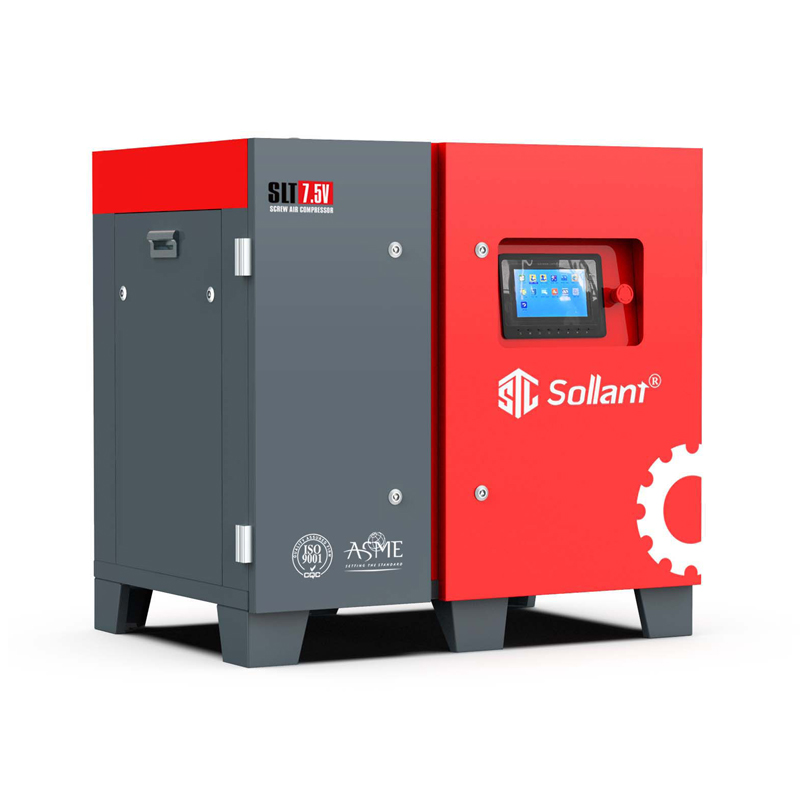
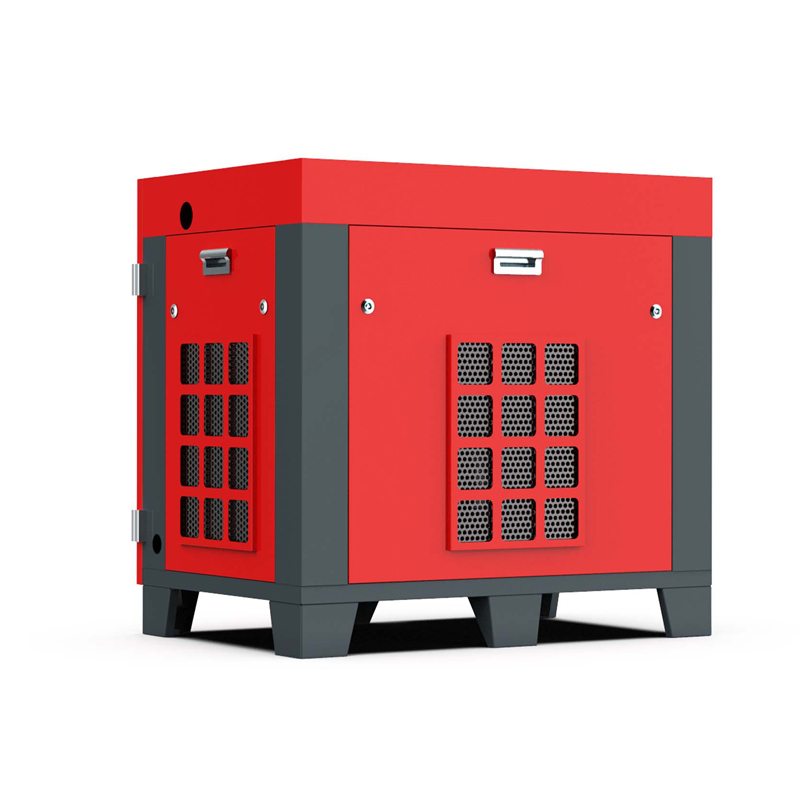
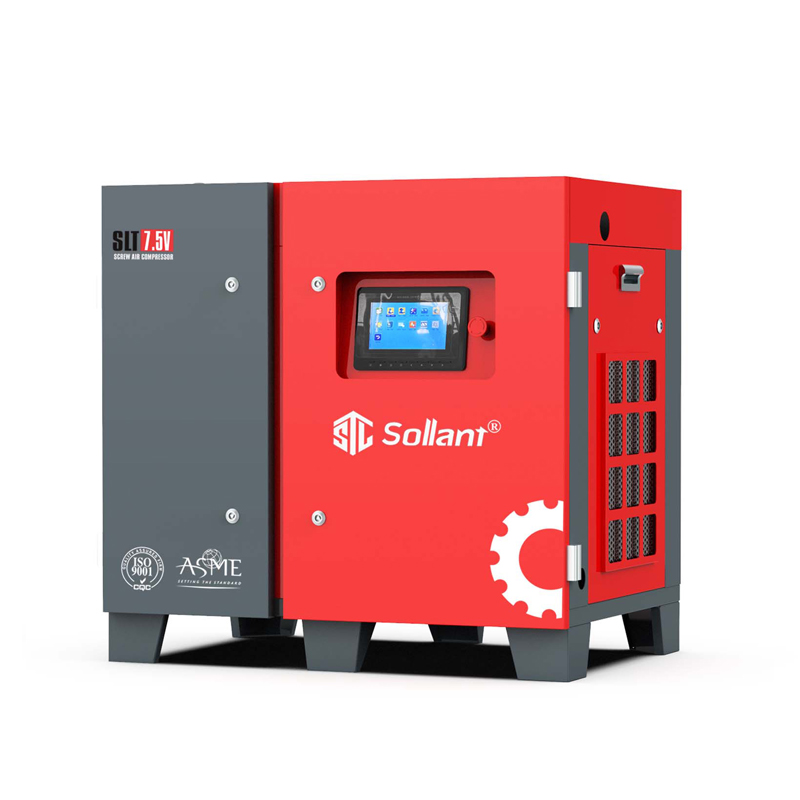
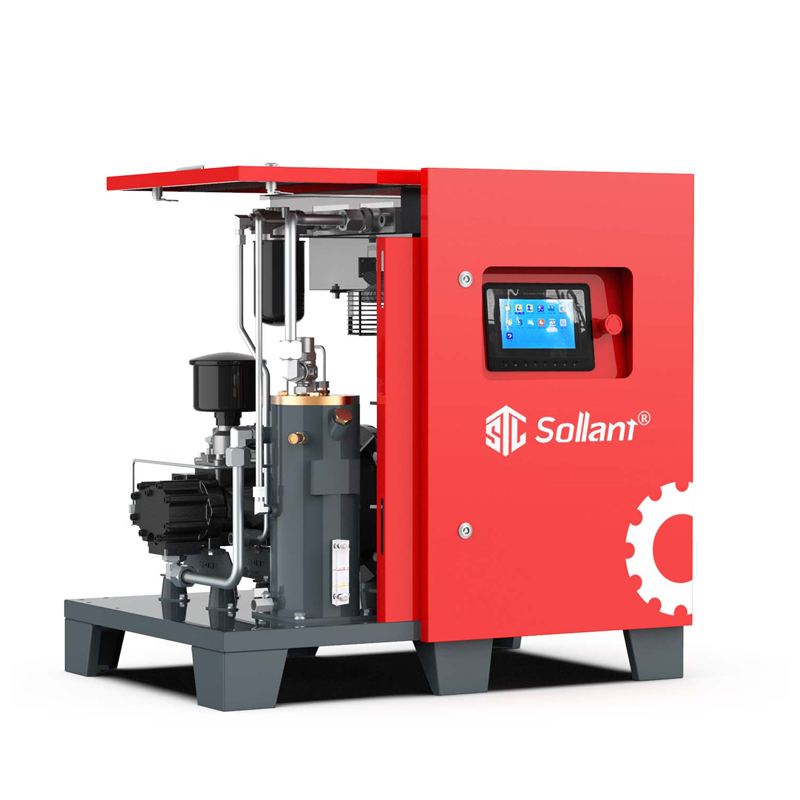












We hope to let you know our advantages and win-win cooperation in the least time.
Screw air end, high efficiency, low speed, the rotor adopts the third generation 5:6 tooth profile, the world’s best profile design, small size, low noise (only 67db), low energy consumption, low maintenance costs, the best reliability and Usability. The permanent magnet motor and the main engine of the compressor adopt a built-in integrated shaft direct connection structure, the structure is more compact, and the transmission efficiency is 100%. There are no motor bearings, and the rotor with permanent magnets is mounted directly on the protruding shaft of the male rotor, eliminating motor bearing failure points.
Screw air end, high efficiency, low speed, the rotor adopts the third generation 5:6 tooth profile, the world’s best profile design, small size, low noise (only 67db), low energy consumption, low maintenance costs, the best reliability and Usability. The permanent magnet motor and the main engine of the compressor adopt a built-in integrated shaft direct connection structure, the structure is more compact, and the transmission efficiency is 100%. There are no motor bearings, and the rotor with permanent magnets is mounted directly on the protruding shaft of the male rotor, eliminating motor bearing failure points.
The high-efficiency permanent magnet motor makes the rotor rotate through the magnetic field and magnetic force generated by the AC voltage related to the stator coil, with low speed and high efficiency. Compared with ordinary FM motors, the energy-saving performance is superior.
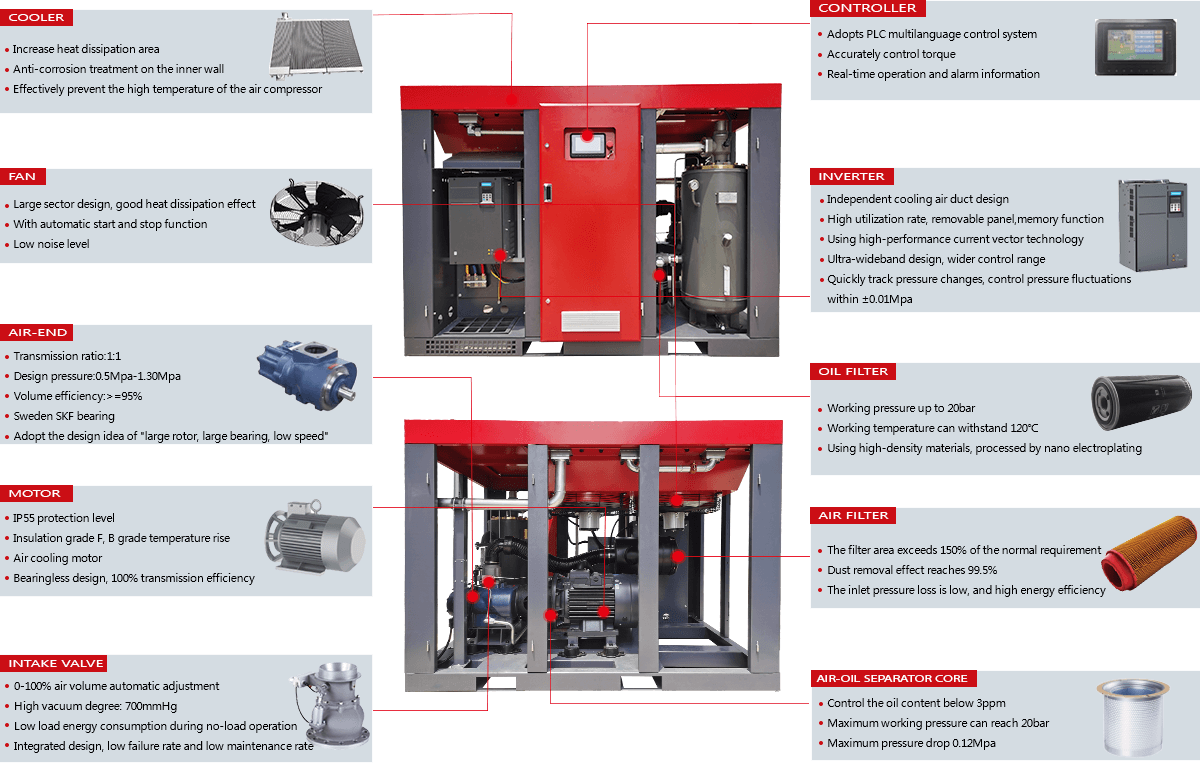
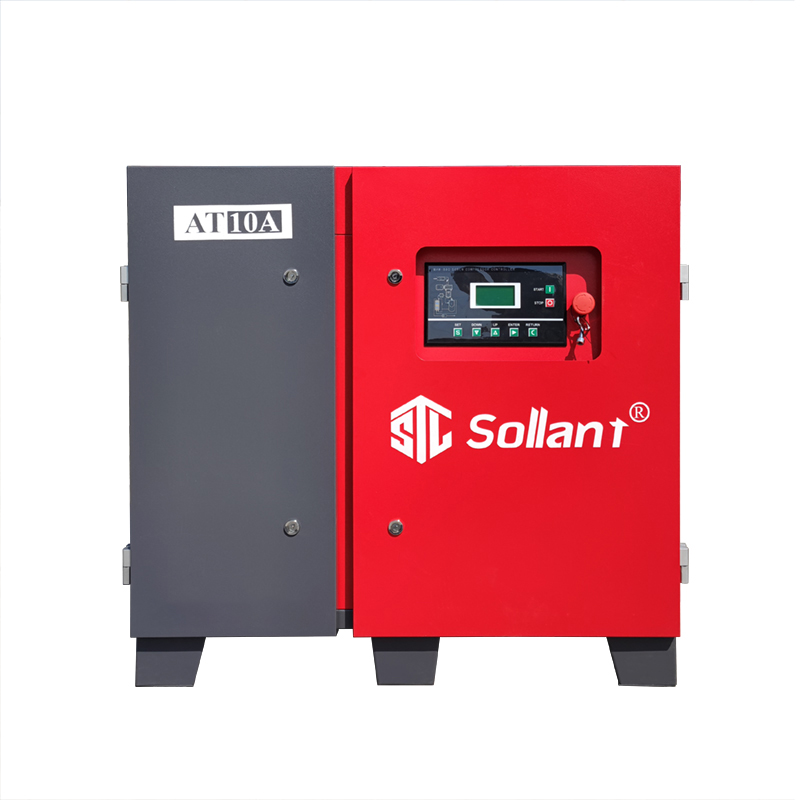
In today’s fast-paced world, energy efficiency has emerged as a critical concern for industries and businesses seeking sustainable growth. The demand for reduced energy consumption not only aligns with cost-saving objectives but also plays a pivotal role in mitigating environmental impacts.
As industries strive to strike a balance between productivity and responsible resource utilization, innovations in technology continue to reshape the landscape of energy-intensive processes.
Among these innovations, variable-speed air compressors have emerged as a key solution for optimizing energy consumption in various sectors. These compressors represent a departure from traditional fixed-speed models, introducing a dynamic approach to air compression that adapts to real-time demand.
By intelligently adjusting motor speed to match the precise air output needed, variable speed compressors present a compelling case for achieving energy efficiency without compromising performance.
Traditional fixed-speed air compressors have long been the workhorses of industrial processes, delivering a steady stream of compressed air to power a wide range of applications. These compressors operate at a constant speed, maintaining a consistent air output regardless of the actual demand.
While effective in generating the required pressure, fixed-speed compressors can prove inefficient when confronted with variable or fluctuating air consumption needs. This often results in excess energy consumption, leading to higher operational costs and unnecessary wear and tear on the equipment.
Variable-speed air compressors represent a significant departure from this conventional approach. By leveraging advanced technology, these compressors offer a more adaptive and responsive solution to air compression needs.
Unlike their fixed-speed counterparts, variable-speed compressors feature motors that can adjust their rotational speed based on the actual demand for compressed air. This capability allows the compressor to operate at different speeds, scaling its output up or down in real time as the application requires.
At the heart of variable speed technology is the concept of “demand-driven” operation. Variable speed air compressors are designed to precisely match the air output to the specific needs of the application at any given time. When demand is low, the compressor slows down, reducing motor speed and subsequently consuming less energy. Conversely, during peak demand periods, the compressor ramps up its speed to deliver higher air volumes, all while ensuring optimal pressure levels are maintained.
This ability to modulate the motor speed according to demand provides two critical advantages. Firstly, it eliminates the inefficiencies associated with fixed-speed compressors running continuously, even during periods of low demand. Secondly, it minimizes the energy-intensive process of starting and stopping the motor frequently, which can significantly reduce wear and tear on the equipment while prolonging its operational life.
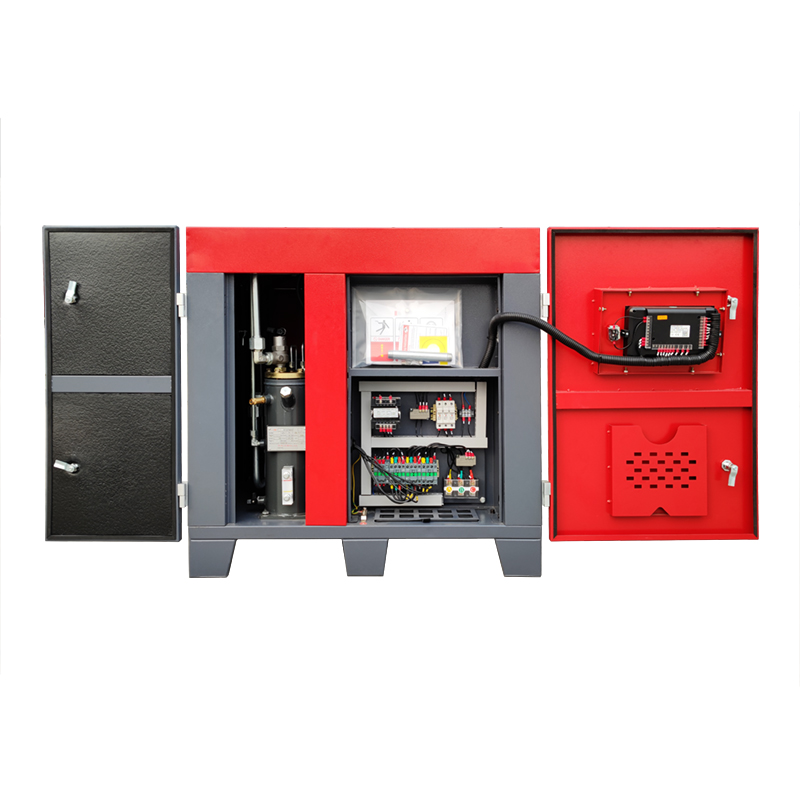
The shift towards variable-speed air compressors heralds a paradigm shift in the world of air compression technology. These modern marvels offer a host of advantages over their traditional fixed-speed counterparts, positioning them as a preferred choice for businesses aiming to achieve energy efficiency and operational excellence.
Reduction in Energy Consumption
One of the primary benefits of variable speed technology lies in its inherent ability to reduce energy consumption. Unlike fixed-speed compressors, which operate continuously regardless of actual demand, variable-speed compressors only consume energy commensurate with the required air output. By adjusting the motor speed to match the specific needs of the application, variable-speed compressors minimize wasteful energy consumption during periods of low demand.
Fewer Motor Starts and Stops
Fixed-speed compressors often cycle on and off to maintain a constant pressure level, leading to frequent motor starts and stops. These repeated start-up sequences not only consume additional energy but also contribute to mechanical wear. In contrast, variable speed compressors mitigate the need for frequent motorcycling by smoothly adjusting their speed to accommodate fluctuations in demand. As a result, energy-intensive motor start-ups are minimized, contributing to reduced maintenance needs and enhanced equipment longevity.
Enhanced System Efficiency through Pressure Stability
Pressure fluctuations can have far-reaching implications for industrial processes, affecting the precision of machinery, tool performance, and overall system efficiency. Variable-speed air compressors excel in maintaining consistent pressure levels. By instantly adapting to changes in demand, they eliminate the peaks and valleys commonly associated with fixed-speed compressors. This translates into smoother, more reliable operations across a range of applications, from manufacturing and automotive assembly to pharmaceutical production.
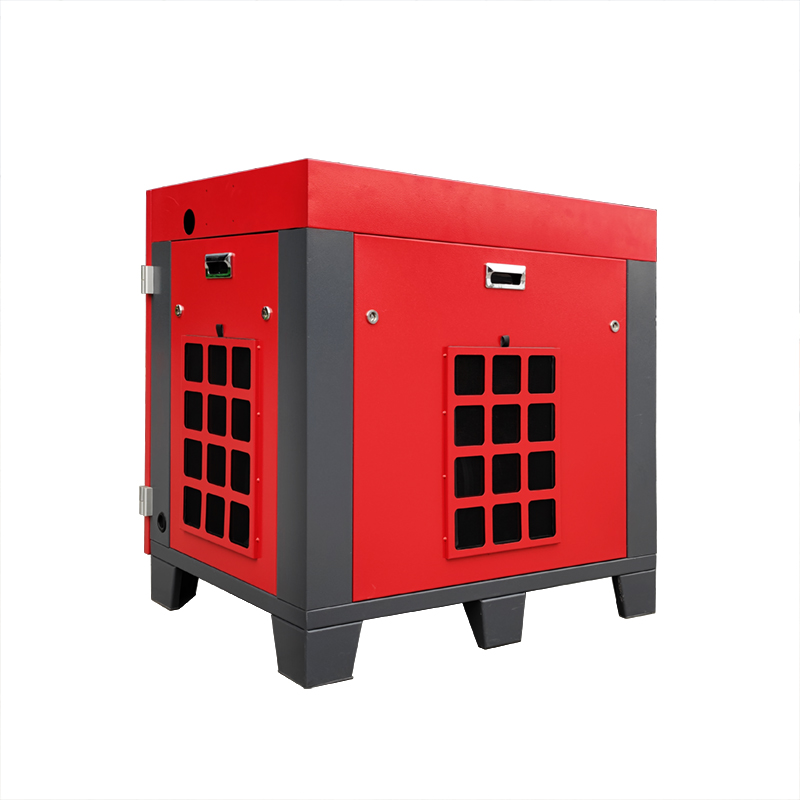
One of the cornerstones of energy savings achieved by variable speed air compressors is the concept of “part load” efficiency. In many industrial processes, the air demand varies widely throughout the operational cycle.
Fixed-speed compressors are engineered to perform optimally at full capacity, but when operating at partial loads, they experience diminishing returns in efficiency. Variable speed compressors, on the other hand, excel precisely in such scenarios.
The secret behind the energy-saving prowess of variable speed compressors lies in their ability to modulate motor speed in response to varying air demand. When demand is high, the compressor increases its speed to deliver the required air volume.
Conversely, during periods of low demand, the compressor reduces its speed, aligning air output with actual requirements. This fine-tuned adjustment ensures that the compressor consistently operates at its peak efficiency, even under varying conditions.
To underscore the practical impact of variable speed technology on energy savings, consider real-world examples from different industries. In a manufacturing facility, a variable speed air compressor seamlessly adjusts its speed to match the fluctuations in air demand during production cycles. As a result, it consumes significantly less energy compared to a fixed-speed compressor operating at full capacity throughout. The outcome is not only reduced energy costs but also decreased wear on the equipment.
In another scenario, a commercial building uses a variable speed compressor to maintain steady air pressure for HVAC systems. The compressor’s ability to operate at different speeds based on demand translates into substantial energy savings, especially during periods of reduced cooling or heating requirements.
Case Studies: Validation of Energy Efficiency
Several case studies provide tangible evidence of the energy cost reductions achieved through the adoption of variable speed technology. These studies showcase instances where businesses have experienced notable reductions in energy consumption and associated operational expenses. By sharing these success stories, we gain insights into how variable speed air compressors are reshaping energy management practices across industries.
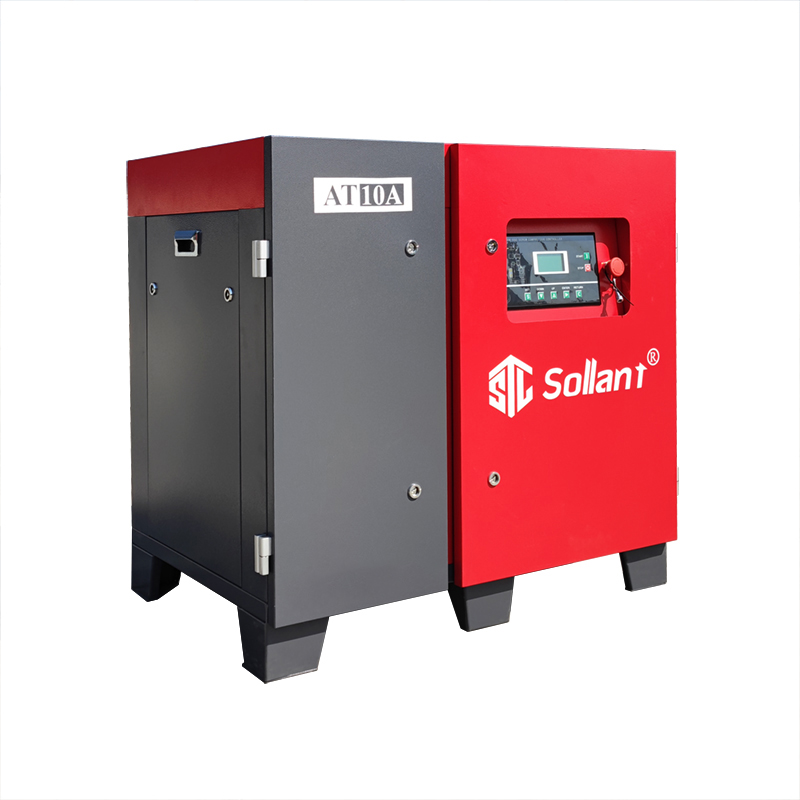
While the benefits of variable speed compressors in energy efficiency are evident, quantifying the actual energy savings is crucial for businesses seeking to make informed decisions. There are several methods that can be employed to calculate the energy savings achieved through the adoption of variable speed technology.
Three key parameters play a pivotal role in estimating energy savings:
The potential for substantial cost savings over the long term is a compelling driver for businesses to transition to variable speed compressors. By reducing energy consumption during periods of lower demand, businesses can experience a remarkable decrease in operational expenses. This financial advantage becomes even more pronounced when considering the extended lifespan of the equipment due to reduced wear and tear from frequent motorcycling.
The transformative impact of variable speed air compressors on energy cost reductions is vividly demonstrated through real-world examples across diverse industries. These examples underscore how businesses across sectors are reaping substantial benefits by embracing the efficiency offered by variable speed technology.
Manufacturing Sector: In a metal fabrication plant, a transition from fixed-speed to variable-speed air compressors yielded remarkable results. The compressors adjusted their output to match the fluctuating demands of cutting, welding, and finishing processes. The outcome was not only a reduction in energy consumption but also an extended equipment life span due to decreased wear and tear. This manufacturing facility experienced a 30% reduction in energy costs within the first year of adopting variable-speed compressors.
Commercial Building Management: Consider a commercial building’s HVAC system, which relies on air compressors to maintain optimal air pressure. With variable speed compressors, the system dynamically adjusted its output based on heating and cooling requirements. This strategic approach resulted in energy savings of up to 40%, a noticeable decrease in maintenance needs, and a substantial decrease in operating costs over time.
To provide tangible evidence of the benefits of variable speed technology, let’s examine energy consumption patterns before and after transitioning to variable speed air compressors:
Before: Fixed-speed compressors operating continuously led to consistent energy consumption, regardless of demand fluctuations. This resulted in high energy bills and increased wear on equipment due to frequent motor starts and stops.
After: Upon adopting variable speed compressors, the energy consumption pattern witnessed a dramatic shift. The compressors now adjusted their speed to match demand, significantly reducing energy consumption during periods of lower demand. The result was a smoother, more adaptive energy consumption curve that directly translated into reduced operational costs.

While variable speed technology plays a central role in optimizing energy efficiency, the synergy of additional features further elevates the overall performance of variable speed air compressors. These complementary elements work in tandem with variable speed technology, enhancing energy savings and operational excellence.
Integrated Air Treatment Systems
Integrated air treatment systems, including refrigerated dryers and filters, contribute significantly to overall efficiency. By ensuring that the compressed air is clean, dry, and free from contaminants, these systems prevent excessive pressure drops and help maintain optimal compressor performance. In turn, this translates to reduced energy consumption, as the compressor operates in an environment conducive to efficiency.
Advanced Controls and Monitoring
Advanced control systems are a hallmark of modern variable speed compressors. These systems allow for precise monitoring and adjustment of compressor parameters, enabling real-time optimization. For instance, smart controllers can detect variations in demand and adjust compressor output accordingly. By ensuring that the compressor operates at its most efficient point, these controls prevent unnecessary energy consumption during periods of low demand.
Optimizing Overall Compressor Performance
The integration of complementary features with variable speed technology creates a holistic approach to energy efficiency. For instance, an integrated air treatment system ensures that the air delivered by the compressor is of high quality, reducing the need for re-compression due to contamination. This directly translates into energy savings, as the compressor expends less energy to achieve the desired output.
Additionally, advanced control systems work in concert with variable speed technology to maintain precise control over motor speed and pressure levels. By constantly adapting to changing demand and adjusting the compressor’s operation, these systems further minimize energy consumption. In essence, the seamless interaction between these features ensures that the compressor’s performance is optimized at all times, enhancing both energy efficiency and overall system reliability.
Investing in variable speed air compressors goes beyond energy savings; it presents a compelling financial case that enhances a company’s bottom line. The return on investment (ROI) associated with these compressors is a testament to the sustainable financial advantages they bring to businesses.
Several key factors influence the ROI of variable speed air compressors:
The energy savings realized through variable speed technology play a pivotal role in achieving a shorter payback period. A shorter payback period denotes the time it takes for the accumulated energy savings to equal the initial investment cost of the compressor. Given that variable speed compressors can achieve up to 35% energy savings, the payback period can be significantly shorter compared to traditional fixed-speed compressors.
Consider a scenario where a manufacturing facility experiences an energy cost reduction of $10,000 annually by transitioning to variable speed compressors. If the initial investment in the compressors is $30,000, the payback period would be a mere three years. Beyond the payback period, the energy savings translate directly into increased profitability.
Incorporating variable speed air compressors into an organization’s operations is a strategic move that offers both immediate and long-term financial benefits. As energy costs continue to rise and sustainability gains prominence, the ROI associated with variable speed compressors becomes even more compelling. By leveraging energy-efficient technology, businesses not only reduce their environmental footprint but also achieve a robust financial advantage that bolsters their competitive edge in the market.
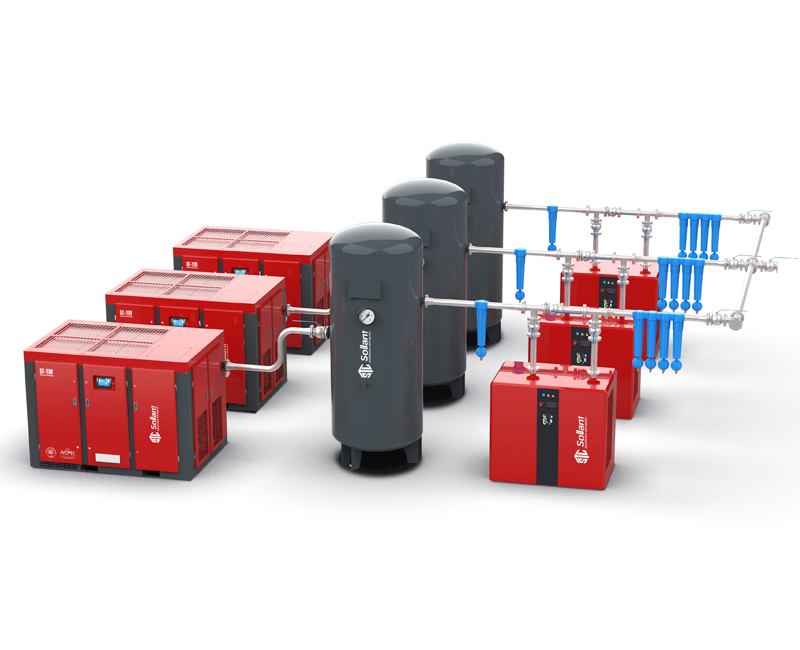
Environmental Benefits of Reduced Energy Consumption
The adoption of variable speed air compressors transcends financial gains; it holds immense promise for reducing the environmental footprint of industrial operations. By curbing energy consumption, these compressors contribute to a range of environmental benefits that align with the urgent need for sustainability.
Mitigating Carbon Footprint
Reduced energy consumption directly translates to a smaller carbon footprint. Carbon emissions associated with energy production contribute to climate change and environmental degradation. Variable speed compressors, through their energy-efficient operation, play a role in mitigating carbon emissions by consuming less energy from conventional sources, such as fossil fuels. As industries increasingly seek ways to minimize their impact on the environment, variable speed technology emerges as a crucial ally in this endeavor.
Empowering Sustainability Initiatives
Variable speed air compressors embody the essence of sustainability. They exemplify the power of technology to drive efficiency without compromising performance. Businesses adopting variable speed technology demonstrate their commitment to responsible resource utilization and eco-conscious operations. These compressors become a cornerstone of broader sustainability initiatives that aim to balance economic growth with environmental stewardship.
Corporate Social Responsibility (CSR)
Corporate social responsibility has gained prominence as businesses recognize their role in contributing to societal and environmental well-being. By integrating variable speed air compressors into their operations, companies showcase their dedication to reducing energy consumption and fostering sustainable practices. This commitment resonates with stakeholders, including customers, investors, and employees, who increasingly value organizations that prioritize environmental responsibility.
A Pathway to a Greener Future
As industries navigate a landscape defined by environmental concerns, variable speed air compressors emerge as an essential tool for progress. By diminishing energy consumption and emissions, they contribute to a more sustainable and resilient industrial ecosystem. Beyond the immediate financial benefits, the environmental impact of these compressors reflects a commitment to safeguarding the planet for future generations.
In the realm of energy-efficient screw air compressor manufacturing, one name shines bright: Sollant. With a steadfast commitment to innovation, quality, and sustainability, Sollant has emerged as a leading player in the Turkish industrial landscape. Specializing in the development and production of cutting-edge screw air compressors, Sollant is transforming the way industries approach compressed air solutions.
At the heart of Sollant’s mission lies an unwavering dedication to energy efficiency. Recognizing the crucial role of compressed air systems in diverse industrial applications, Sollant strives to minimize the environmental impact while maximizing operational efficiency. By harnessing advanced technologies and engineering excellence, Sollant’s screw air compressors embody the pinnacle of energy-efficient design.
Sollant’s journey to becoming a torchbearer of energy efficiency is paved with relentless research and development (R&D). Their team of visionary engineers and researchers constantly push the boundaries of compressor technology, seeking novel ways to optimize performance while conserving energy. This commitment to innovation has birthed a range of screw air compressors that not only meet industry standards but exceed them.
What sets Sollant apart is their holistic approach to compressor design. Every component, from the precision-engineered screw elements to the intelligent control systems, is meticulously crafted to align with the principles of energy efficiency. Sollant’s compressors boast not only exceptional performance metrics but also reduced energy consumption, translating into tangible cost savings for businesses.
Sollant’s success is underpinned by a customer-centric ethos. Their solutions are tailored to address the specific needs of businesses, ensuring optimal performance, reliability, and cost-effectiveness. The comprehensive support offered by Sollant extends beyond the point of sale, with a commitment to ongoing maintenance, service, and technical assistance.
In the ever-evolving landscape of industrial innovation, Sollant emerges as a trailblazer, redefining the standards of efficiency and sustainability in screw air compressor manufacturing. With a focus on energy efficiency, innovative R&D, and customer satisfaction, Sollant is not just a manufacturer; it’s a catalyst for positive change in the way industries utilize compressed air. As the world looks to achieve the delicate balance between progress and responsibility, Sollant’s energy-efficient screw air compressors stand as beacons of hope for a brighter, greener future.